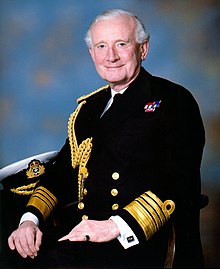Jock Slater
Sir John "Jock" Cunningham Kirkwood Slater , GCB (born March 27, 1938 ) is a former British admiral in the Royal Navy , who was Deputy Chief of Defense from 1993 to 1995 and between 1995 and 1998 First Sea Lord and Chief of Naval Staff. In his retirement he served as Chairman of the Board of Directors of the Imperial War Museum from 2001 to 2006 .
Life
Family origins, naval officer and ship commander

John "Jock" Cunningham Kirkwood Slater, son of the neurologist James Kirkwood Slater and his wife Margaret Claire Byrom Bramwell and grandson of the neurologist Edwin Bramwell , began training as a naval officer at the Britannia Royal Naval College after attending the Edinburgh Academy and the Sedbergh School, founded in 1525 in Dartmouth and after graduation found numerous uses as an officer and staff officer. He was, among others between August 1976 and December 1977 as a sea captain (Captain) commander of the destroyer HMS Kent and from May 1981 to June 1983 the first commander of the lodged in June 1982 in service aircraft carrier HMS Illustrious . He was then between July 1983 and May 1985 commandant of the School of Maritime Operations (School of Maritime Operations) , which was called HMS Dryad .
As Rear Admiral (Rear Admiral) was Slater June 1985 to September 1987 of assistive Chief of the Defense Staff for Policy and Nuclear Affairs (Assistant Chief of the Defense Staff, Policy and Nuclear) and triggered following as Vice Admiral (Vice-Admiral) in October 1987, Vice Admiral George Vallings as Flag Officer, Scotland and Northern Ireland, and was thus Commander of the Naval Forces in Scotland and Northern Ireland . He held this post until February 1989 and was then replaced by Vice Admiral Michael Livesay . For his services he was beaten on June 11, 1988 to Knight Commander of the Order of the Bath (KCB) and from then on carried the suffix "Sir". He then took over in March 1989 by Vice Admiral David Benjamin Bathurst the post of Fourth Sea Lord and Chief of Fleet Support (Fourth Sea Lord and Chief of Fleet Support) and remained in this office until January 1991, after which Vice-Admiral Neville Purvis became his successor.
Promotion to Admiral and First Sea Lord
In January 1991, Admiral Jock Slater succeeded Admiral David Benjamin Bathurst again, this time as Commander-in-Chief (The Fleet) and held this position until he was replaced by Admiral Hugo White in December 1992. Am June 13, 1992 he was raised to the Knight Grand Cross of the Order of the Bath (GCB). Then he was in January 1993 in office as Vice-Chief of the Defense Staff again successor to Admiral David Benjamin Bathurst. He held this position until April 1995 and was then replaced by Air Chief Marshal John Frederick Willis . Most recently, he broke for the fourth time nunmehrigen Commodore (Admiral of the Fleet) David Benjamin Bathurst in July 1995 as First Sea Lord (First Sea Lord) , and was this capacity until his retirement from active military service in October 1998, also Chief of the Naval Staff ( Chief of the Naval Staff) . In October 1998, Admiral Michael Boyce succeeded him in these offices.
Jock Slater was a member of the supervisory board of the shipbuilding company VT Group and the British supervisory board of the US defense and technology group Lockheed Martin . He was also Chairman of the Executive Committee of the rescue organization Royal National Lifeboat Institution (RNLI) and Deputy Lieutenant of the County of Hampshire . It was founded in 2001 as the successor to Air Chief Marshal Joseph Gilbert Chairman of the Board ( Board of Directors ) of the Imperial War Museum and this function had five years held until 2006, after which Air Chief Marshal Peter Squire took over his local successor. He is also involved as a so-called Elder Brother in the Trinity House beacon management and as a liveryman for the Worshipful Company of Shipwrights , the shipbuilders' guild. He also became an honorary citizen ( Freeman of the City ) of the City of London .
Web links
- ROYAL NAVY SENIOR APPOINTMENTS SINCE 1865
- CAPTAINS COMMANDING ROYAL NAVY WARSHIPS
- MINISTRY OF DEFENSE AND TRI-SERVICE SENIOR APPOINTMENTS
- KNIGHTS AND DAMES in Leigh Rayment's Peerage Page
Individual evidence
- ↑ CAPTAINS COMMANDING ROYAL NAVY WARSHIPS, p. 270
- ↑ CAPTAINS COMMANDING ROYAL NAVY WARSHIPS, p. 107
- ↑ ROYAL NAVY SENIOR APPOINTMENTS SINCE 1865, p. 262
- ↑ MINISTRY OF DEFENSE AND TRI-SERVICE SENIOR APPOINTMENTS, p. 9
- ↑ ROYAL NAVY SENIOR APPOINTMENTS SINCE 1865, p. 80
- ↑ KNIGHTS AND DAMES
- ↑ ROYAL NAVY SENIOR APPOINTMENTS SINCE 1865, p. 12
- ↑ ROYAL NAVY SENIOR APPOINTMENTS SINCE 1865, p. 132
- ↑ KNIGHTS AND DAMES
- ↑ MINISTRY OF DEFENSE AND TRI-SERVICE SENIOR APPOINTMENTS, p. 5
- ↑ ROYAL NAVY SENIOR APPOINTMENTS SINCE 1865, p. 6
| predecessor | Office | successor |
|---|---|---|
| Sir David Benjamin Bathurst |
Fourth Sealord and Chief of Fleet Support 1989-1991 |
Sir Neville Purvis |
| Sir David Benjamin Bathurst | Commander-in-Chief, The Fleet 1981-1992 |
Sir Hugo White |
| Sir David Benjamin Bathurst | Vice-Chief of the Defense Staff 1993-1995 |
Sir John Frederick Willis |
| Sir David Benjamin Bathurst |
First sea lord 1995–1998 |
Sir Michael Boyce |
| personal data | |
|---|---|
| SURNAME | Slater, jock |
| ALTERNATIVE NAMES | Slater, John Cunningham Kirkwood (full name) |
| BRIEF DESCRIPTION | British admiral |
| DATE OF BIRTH | March 27, 1938 |

